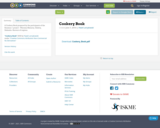
A Cookery Book prepared by the participants of the Erasmus + project - Warmia-Masuria, Umbria, Dalmatia -flavours of regions.
- Subject:
- Career and Technical Education
- Education
- English Language Arts
- Material Type:
- Data Set
- Date Added:
- 06/07/2018

A Cookery Book prepared by the participants of the Erasmus + project - Warmia-Masuria, Umbria, Dalmatia -flavours of regions.

A cooking dictionary prepared by the participants of the Erasmus + project - Warmia-Masuria, Umbria, Dalmatia -flavours of regions.
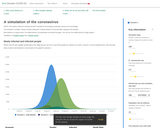
Corona-land is a simulator that visualizes how a virus like the coronavirus spreads and what we can do to contain it. This is an exploration and learning tool and is not a professional tool intended at decision making, planning or forecasting.
Designed and developed by Thomas Riisgaard Hansen, Kite Invent og Aarhus Universitet
Graphic Assistance by Tue Pico, Javira
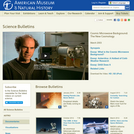
This AstroBulletin article takes an in-depth look at the newest technology and instruments used to study the Cosmic Microwave Background. The site includes text and a seven minute video. There are links to three essays: "What Is the Cosmic Microwave Background?", "Antarctica: A Hotbed of Cold-Weather Research" and "DASI Does It."
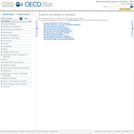
Database of a series of statistical indicators, primarily economic, but also social and educational, on each OECD countries. Can be viewed either online or downloaded as excel files. The excel downloads also allow for graphical comparisons with other OECD countries.
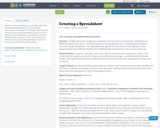
Students create a spreadsheet to quantify, analyze and determine the experiences and views towards technology of the Computer Commuter users.
Students create the layout of the spreadsheet that best suits the data in the survey. Questions are in different formats: multiple choice and short answer. The student must determine how to set up the spreadsheet to make the data easy and efficiently understandable.

This a a cross curricular unit encompassing English, History, and Math Common Core Standards to teach the Child Labor practices of 1800s U.S. with the tragedy of Triangle Shirtwaist Factory Fire of 1911 which lead to child labor reform throughout the world and into the modern era.
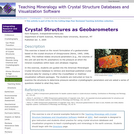
This exercise is based on the recent formulation of a geobarometer based on the crystal structure of clinopyroxene (Nimis, 1995; 1998; 1999). This method relates structural parameters (e.g., the volumes of the unit cell and the M1 polyhedron) to the pressure at which the mineral crystallizes within basic and ultrabasic magmas.
In this exercise, students are guided into the American Mineralogist Crystal Structure Database to retrieve and download published crystal structure data for viewing in either the CrystalMaker or XtalDraw visualization software packages. The students are instructed on how to examine the structures to determine pressure-sensitive crystallographic parameters and are asked a series of questions related to what they learn.
(Note: this resource was added to OER Commons as part of a batch upload of over 2,200 records. If you notice an issue with the quality of the metadata, please let us know by using the 'report' button and we will flag it for consideration.)
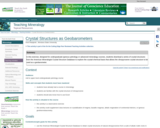
This exercise is based on the recent formulation of a geobarometer based on the crystal structure of clinopyroxene (Nimis, 1995; 1998; 1999). This method relates structural parameters (e.g., the volumes of the unit cell and the M1 polyhedron) to the pressure at which the mineral crystallizes within basic and ultrabasic magmas.
students are guided into the American Mineralogist Crystal Structure Database to retrieve and download published crystal structure data for viewing in either the CrystalMaker or Xtaldraw visualization software packages.
students are instructed on how to examine the structures to determine pressure-sensitive crystallographic parameters
students are then asked a series of questions related to what they learn.
(Note: this resource was added to OER Commons as part of a batch upload of over 2,200 records. If you notice an issue with the quality of the metadata, please let us know by using the 'report' button and we will flag it for consideration.)
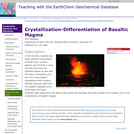
In this exercise, students use major-element compositions of whole-rocks, volcanic glasses, and minerals in lavas and drill cores from the solidified Kilauea Iki lava lake. The data is presented in the form of a "precompiled" spreadsheet which contains selected analyses culled from the GEOROC database and a USGS Open File report. Students make graphs from the data to learn about the petrologic processes related to the eruption and in situ crystallization of basaltic magma
(Note: this resource was added to OER Commons as part of a batch upload of over 2,200 records. If you notice an issue with the quality of the metadata, please let us know by using the 'report' button and we will flag it for consideration.)

This digital archive is an aid in understanding how British, Canadian and especially U.S. nationals managed and, on occasion, challenged informal empire in 1940s and 1950s Cuba. Cuba’s Anglo-American Colony in Times of Revolution documents how, in the context of revolution, contact between Cubans and U.S. nationals–as well as a smaller number of British and Canadian residents–reproduced existing hierarchies, while simultaneously creating new empathies. Cuba’s Anglo-American residents managed informal empire by developing and cultivating economic, political and cultural authority on the island. These privileged outsiders were able to exert dominance through socioeconomic partnerships with Cuban powerbrokers. However, Anglo-American educators, journalists, missionaries, politicians, executives, mobsters and philanthropists crafted a diverse, and often contradictory set of alliances with Cubans. In the context of revolution, where their Cuban colleagues, classmates, students, parishioners, friends and family risked their lives and their privilege for a “new” Cuba, a significant segment of Anglo-American residents entered into cross-cultural solidarities with revolutionary actors. Based on the personal commitments they developed with Cubans, many U.S., British and Canadian nationals residing in Cuba struggled for a socioeconomic and political transformation of Cuban society, both before the revolution ousted the Batista government and after the revolutionary government had consolidated power. This archive centers a new set of actors, institutions, and relationships in the narrative of the Cuban Revolution.

Curate Science is a unified curation system and platform to verify that research is transparent and credible. It will allow researchers, journals, universities, funders, teachers, journalists, and the general public to ensure:- Transparency: Ensure research meets minimum transparency standards appropriate to the article type and employed methodologies.- Credibility: Ensure follow-up scrutiny is linked to its parent paper, including critical commentaries, reproducibility/robustness re-analyses, and new sample replications.
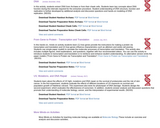
In this activity, students extract DNA from Archaea or from their cheek cells. Students learn key concepts about DNA function during the intervals required for the extraction procedure. Student understanding of DNA structure, function and replication is further developed by additional analysis and discussion questions and hands-on modeling of DNA replication. This activity helps students meet the Next Generation Science Standards.
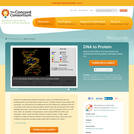
Explore the relationship between the genetic code on the DNA strand and the resulting protein and rudimentary shape it forms. Through models of transcription and translation, you will discover this relationship and the resilience to mutations built into our genetic code. Start by exploring DNA's double helix with an interactive 3D model. Highlight base pairs, look at one or both strands, and turn hydrogen bonds on or off. Next, watch an animation of transcription, which creates RNA from DNA, and translation, which 'reads' the RNA codons to create a protein.
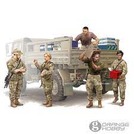
El propósito de este manual es determinar procedimientos generales para el oficial y personal militar que ejerce la función logística, con el fin de que se administren los medios o recursos de tal forma que pueda ejecutar un apoyo logístico integral eficiente como oportuno al personal y unidades militares en el teatro de operaciones.
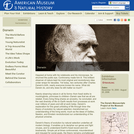
This Web site examines Charles Darwin and his theory that changed the course of science and society. The site includes information that was presented in the Museum's Darwin exhibit. Society's beliefs about the natural world and the Earth's age at the start of the 1800s are summarized. Darwin's education and work and the development of his theory of evolution by natural selection, including the reasons he kept his theory secret for so long and the consequences of finally publishing his work are presented. There is also a look at how today's knowledge and tools have helped advance Darwin's theory.

The AMNH Darwin Manuscripts Project is a historical and textual edition of Charles Darwin's scientific manuscripts, designed from its inception as an online project. The database at its coreŰÓDARBASEŰÓcatalogues some 45,000 Darwin scientific manuscripts. These are currently represented by 15,125 high resolution digital images. Thus far 7,428 manuscript pages have been transcribed to exacting standards and all are presented in easy to read format. New material will be added.
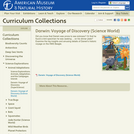
This online article is from the Museum's Science Explorations, a collaboration between AMNH and Scholastic designed to promote science literacy. Written for students in grades 6-10, this article from Science World magazine has an interview with AMNH paleontologist Niles Eldredge, in which he explains how the eye-opening sights Charles Darwin encountered during his five-year voyage on the HMS Beagle inspired his thinking about the diversity of life on Earth. There are Web links that offer further opportunities for learning about Darwin and his years after the voyage.

CODAP (Common Online Data Analysis Platform) is an open-source data visualization and analysis tool made available by the Concord Consortium. It's available at https://codap.concord.org/. CODAP can be used across the curriculum to help students summarize, visualize, and interpret data, advancing their skills to use data as evidence to support a claim.
This professional learning resource includes guides to get started, tutorials that demonstrate the features and functionality of CODAP, sample lessons, and links to online forum sites.
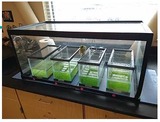
Use data sets from a group of ninth grade students to analyze and draw conclusions, find sources of error, and identify variables and constants.